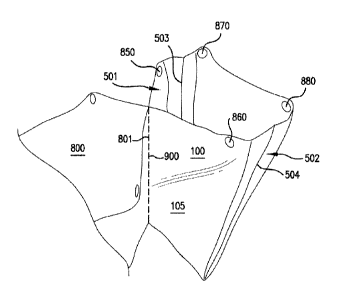Some of the information on this Web page has been provided by external sources. The Government of Canada is not responsible for the accuracy, reliability or currency of the information supplied by external sources. Users wishing to rely upon this information should consult directly with the source of the information. Content provided by external sources is not subject to official languages, privacy and accessibility requirements.
Any discrepancies in the text and image of the Claims and Abstract are due to differing posting times. Text of the Claims and Abstract are posted:
| (12) Patent: | (11) CA 2917641 |
|---|---|
| (54) English Title: | PERFORATED BAGS |
| (54) French Title: | SACS PERFORES |
| Status: | Granted |
| (51) International Patent Classification (IPC): |
|
|---|---|
| (72) Inventors : |
|
| (73) Owners : |
|
| (71) Applicants : |
|
| (74) Agent: | AIRD & MCBURNEY LP |
| (74) Associate agent: | |
| (45) Issued: | 2016-05-03 |
| (86) PCT Filing Date: | 2014-07-23 |
| (87) Open to Public Inspection: | 2015-02-19 |
| Examination requested: | 2016-01-06 |
| Availability of licence: | N/A |
| (25) Language of filing: | English |
| Patent Cooperation Treaty (PCT): | Yes |
|---|---|
| (86) PCT Filing Number: | PCT/US2014/047825 |
| (87) International Publication Number: | WO2015/023408 |
| (85) National Entry: | 2016-01-06 |
| (30) Application Priority Data: | ||||||
|---|---|---|---|---|---|---|
|
The invention features a series of bags having perforations on the front and back panels that connect the back portion of one bag with the front portion of a second bag. The bags are aligned and features holes that are adapted to be received by a stand to support the bags. The bags are packaged and ready to load in a ready to use position. When the bags are separated from each other, the next bag m the continuous series will align and expand to open into a use position. The bags can be stacked on top of each other in a ready to use position.
L'invention concerne une série de sacs présentant des perforations sur les panneaux avant et arrière qui relient la partie arrière d'un premier sac à la partie avant d'un second sac. Les sacs sont alignés et présentent des trous qui sont conçus pour être reçus par un socle pour supporter les sacs. Les sacs sont conditionnés et prêts à être chargés dans une position prête à l'emploi. Lorsque les sacs sont séparés les uns des autres, le sac suivant de la série continue s'alignera et s'étendra pour s'ouvrir dans une position d'utilisation. Les sacs peuvent être empilés les uns sur les autres dans une position prête à l'emploi.
Note: Claims are shown in the official language in which they were submitted.
Note: Descriptions are shown in the official language in which they were submitted.

For a clearer understanding of the status of the application/patent presented on this page, the site Disclaimer , as well as the definitions for Patent , Administrative Status , Maintenance Fee and Payment History should be consulted.
| Title | Date |
|---|---|
| Forecasted Issue Date | 2016-05-03 |
| (86) PCT Filing Date | 2014-07-23 |
| (87) PCT Publication Date | 2015-02-19 |
| (85) National Entry | 2016-01-06 |
| Examination Requested | 2016-01-06 |
| (45) Issued | 2016-05-03 |
There is no abandonment history.
Last Payment of $125.00 was received on 2023-11-10
Upcoming maintenance fee amounts
| Description | Date | Amount |
|---|---|---|
| Next Payment if small entity fee | 2025-07-23 | $125.00 |
| Next Payment if standard fee | 2025-07-23 | $347.00 |
Note : If the full payment has not been received on or before the date indicated, a further fee may be required which may be one of the following
Patent fees are adjusted on the 1st of January every year. The amounts above are the current amounts if received by December 31 of the current year.
Please refer to the CIPO
Patent Fees
web page to see all current fee amounts.
| Fee Type | Anniversary Year | Due Date | Amount Paid | Paid Date |
|---|---|---|---|---|
| Request for Examination | $400.00 | 2016-01-06 | ||
| Application Fee | $200.00 | 2016-01-06 | ||
| Maintenance Fee - Application - New Act | 2 | 2016-07-25 | $50.00 | 2016-01-06 |
| Final Fee | $150.00 | 2016-02-22 | ||
| Registration of a document - section 124 | $100.00 | 2017-03-30 | ||
| Maintenance Fee - Patent - New Act | 3 | 2017-07-24 | $50.00 | 2017-05-18 |
| Maintenance Fee - Patent - New Act | 4 | 2018-07-23 | $50.00 | 2018-07-12 |
| Maintenance Fee - Patent - New Act | 5 | 2019-07-23 | $100.00 | 2019-04-04 |
| Registration of a document - section 124 | 2019-11-12 | $100.00 | 2019-11-09 | |
| Maintenance Fee - Patent - New Act | 6 | 2020-07-23 | $100.00 | 2020-05-06 |
| Maintenance Fee - Patent - New Act | 7 | 2021-07-23 | $100.00 | 2021-04-27 |
| Maintenance Fee - Patent - New Act | 8 | 2022-07-25 | $100.00 | 2021-12-06 |
| Maintenance Fee - Patent - New Act | 9 | 2023-07-24 | $100.00 | 2022-11-26 |
| Maintenance Fee - Patent - New Act | 10 | 2024-07-23 | $125.00 | 2023-11-10 |
Note: Records showing the ownership history in alphabetical order.
| Current Owners on Record |
|---|
| RDC SYSTEMS, LLC |
| Past Owners on Record |
|---|
| CASTRO, DEJA S. |
| RDC SYSTEMS, LLC |